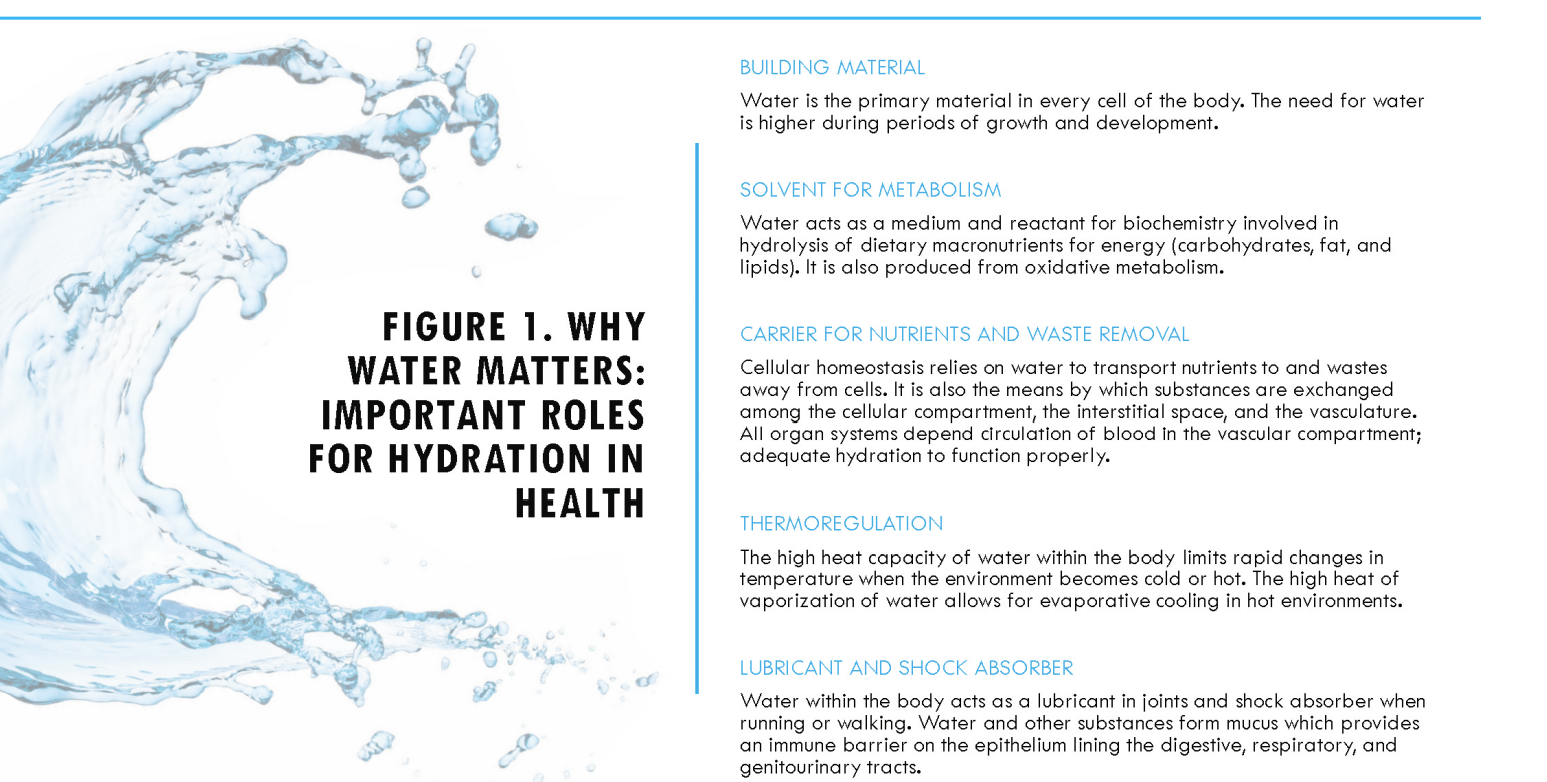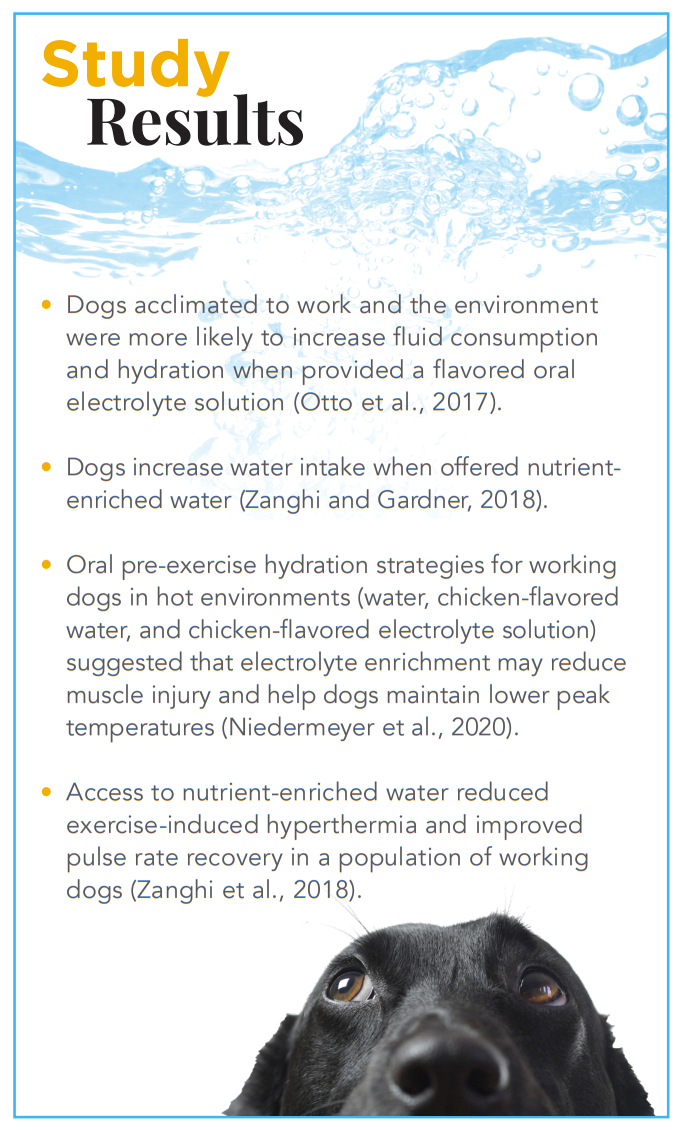The basics of canine hydration: what dogs need and why

Is your dog getting enough water? Here’s what you need to know about canine hydration!
You know that life cannot exist without water. But do you know how your dog’s hydration needs differ from your own? Here’s an overview of how water regulation differs in humans and dogs, with a focus on the physiology of canine dehydration and overheating — conditions that can quickly become life-threatening.
Why water matters
Providing your dog with constant access to fresh water ensures he never goes thirsty. But its benefits don’t end there! Water also maintains the health of his cells, tissues and organs, supports his metabolism, transports nutrients and waste, regulates his body temperature and lubricates his joints (see Figure 1).

The role of electrolytes and nutrients
Water makes up approximately 60% of the weight of healthy, non-obese animals and is divided into different compartments – inside cells (the intracellular compartment) or outside cells (the extracellular compartment). The intracellular compartment is the largest, containing 2/3 of the body’s water. The remaining 1/3 of body water is found in the extracellular compartment.
Plasma (a component of blood) contains water and solutes (e.g. electrolytes, minerals, sugars, proteins, amino acids, enzymes, etc.) that support normal cell function. These substances are often measured as an indicator of whole organism health – and without adequate water, these substances deplete quickly!

The different hydration needs of dogs and humans
Fast fact: Panting is a strategy for heat dissipation that dogs share with other mammals, but not humans. Sweating is uniquely human.
Panting is a type of rapid breathing that enables heat dissipation through evaporation. Air is warmed and humidified upon intake. Heat is dissipated and water is lost through evaporation when the dog breathes out. Naturally, more vigorous exercise generates more heat. In dogs, this results in panting harder to dissipate more heat – an action that dogs are exceptional at!
In humans, heat dissipation involves profuse sweating with subsequent evaporative cooling, salt loss, and skin flushing. Dog skin not only lacks sweat glands and a robust network of cutaneous blood vessels (with the exception of their footpads) but also is covered by a layer of hair that provides insulation from the environment.

Dehydration: what are the signs?
How can you tell if a dog is dehydrated? Mild dehydration can be characterized by dry mucus membranes and lack of skin elasticity, while moderate dehydration increases heartrate. More intense dehydration reduces performance in exercising dogs, and severe dehydration will impact pulse quality and capillary refill time.
Fast fact: Electrolyte loss and dehydration can become life-threatening, with serious clinical signs including hypotension, hypothermia, weak to absent pulses, cold extremities, and/or altered mental abilities.

So how much water does your dog need?
Normal daily water intake for healthy dogs at maintenance (no excessive physiological demands, no illness, and/or no environmental/exercise-induced heat stress) can be found in Table 1. In such conditions, water is lost in urine and feces, and to a much lesser extent, via evaporation from the respiratory tract and footpads. Water loss via the respiratory tract will increase when there is a demand on a dog’s body to dissipate heat through panting. In other words, the harder your dog pants, the more water he needs!
There is no universal scientific consensus on what the daily water needs are in either dogs or humans because there are so many variables beyond the maintenance levels listed in Table 1, including but not limited to: breed, age, ambient temperature, humidity, activity level, body composition, diet, conditioning, and acclimatization.
Fast fact: Providing your dog with constant access to fresh water is the best way to keep him hydrated. Electrolytes designed for dogs can also be added to water.
Special considerations
A significant number of health conditions can impact fluid and electrolyte balance:
- Brachycephalic syndrome (breed-specific heat stress due to inefficient respiration)
- Vomiting/diarrhea
- Trauma/blood loss
- Kidney disease
- Endocrine disease
Additionally, dehydration in working dogs can be affected by dietary effects on metabolism. For these and other conditions, special consideration is merited, and a veterinarian should be consulted before using products that could affect fluid and electrolyte status.
All dogs need adequate water to survive, and in most cases, water absorption is enhanced with the addition of sugar, amino acids, and electrolytes. While plain water can address hydration needs, evidence suggests that dogs drink more total water when offered an oral electrolyte solution in addition to plain water. Happy hydrating!
Shopping memo
Petralyte is a company that offers an electrolyte supplement for dogs. This proprietary formula was created by a team of veterinarians, and can boost hydration while delivering an array of nutrients. It comes in a variety of flavors, including beef, chicken and turkey. Available in serving-sized sachets, it can be simply added to your dog’s water.



